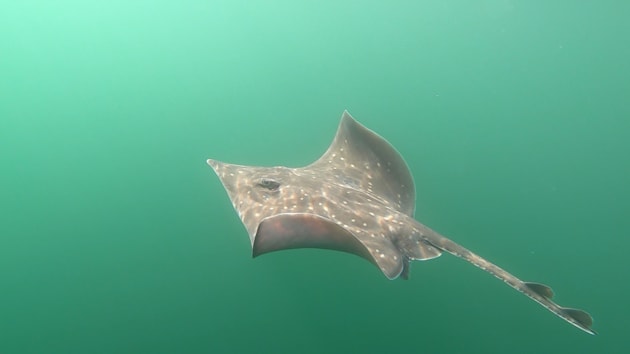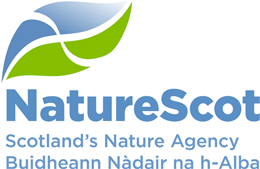08 July, 2025
App to build better picture of endangered flapper skates in Scotland

A new, free app is helping to build a better picture of how critically endangered flapper skates are faring around Scotland’s coasts.
The SkateSpotter mobile app builds on the success of the online flapper skate photo database, which began when angling charter skipper, Ronnie Campbell, gave 400 digital photos of flapper skates to the Scottish Association for Marine Science (SAMS) in 2018. Seven years later, SkateSpotter, curated by NatureScot with contributions by even more anglers, contains over 4,000 photos of over 2,500 individual flapper skates recognisable by their distinctive spot patterns matched with the help of AI.
With the new, free SkateSpotter app now available on the Play and App stores for both android and iPhone users, NatureScot is asking anyone who spots a flapper skate to take a picture and report it. The mobile phone app is designed to make it easier for the public to submit photos on the go, but older photos can also be uploaded since the app recognises the date and time the photo was taken.
The data from Skatespotter has already proven valuable. It was used by scientists at Marine Directorate in Aberdeen to model the population of flapper skate in the Loch Sunart to the Sound of Jura Marine Protected Area (MPA) last year. The model showed that flapper skate are recovering faster inside the MPA than outside.
Jane Dodd, NatureScot’s elasmobranch specialist, added:
“We encourage anglers, divers, fishermen and marine surveyors from all over Scotland to download the SkateSpotter app and become citizen scientists, helping us to understand and restore these amazing animals. An army of volunteers using SkateSpotter could generate a much more significant amount of data than a handful of scientists. Flapper skate are generally resident or show site fidelity (leaving and coming back to a site), but they do travel longer distances and we might be underestimating these because most of our SkateSpotter submissions come from specific areas. Imagine being the person who submits a photo of a skate from Shetland only to find the skate originated from Orkney or the west coast of Scotland!”
Steven Benjamins of the Scottish Association for Marine Science (SAMS) said:
“Most of the data in SkateSpotter is from flapper skate angling in the Loch Sunart to the Sound of Jura MPA because that’s where most of our contributing skippers are based, with some photos from Orkney and Shetland, the Mull of Galloway and Ireland. With the addition of AI to help us match photos, it was time for an app to make it easier for people from all over Scotland to contribute photos of skate and hopefully help us further understand the longer distance movements of these amazing fish.”
Anyone encountering a flapper skate, either when angling, diving, fishing, surveying or walking on the beach, can submit a photo via the app. They will then be asked for additional information on the general area where the skate was seen, whether it is male or female and its size. Once the photo is submitted, it will be matched against others already in the database by AI or added as a new individual. Contributors will be provided with an update on “their” skate if it is reported again and sensitive information like fishing marks will not be shared without permission.
Flapper skate belongs to the elasmobranch or shark family. Instead of bones, it has a skeleton formed of cartilage. Adult flapper skate can reach up to 285cm (for the larger female sex) and seem to prefer deep (100m+) muddy habitats where they eat prawns and other smaller skates and small sharks.
ENDS
Contact information
- Name
- NatureScot Media
- Telephone
- 0131 316 2655
- media@nature.scot
Notes to editors
In 2009 it became illegal to land skate in most of Europe which means any skate caught as bycatch should be released unharmed.
All angling for this species in Scotland is on a “catch and release” basis. Recapturing previously identified skate suggests there is no harm to the fish when released. However, common skate are still at risk from unintentional capture in mobile gear such as trawls and dredges.
More information can be found on the NatureScot website: https://www.nature.scot/plants-animals-and-fungi/fish/sea-fish/flapper-skate
NatureScot is Scotland's nature agency. We work to enhance our natural environment in Scotland and inspire everyone to care more about it. Our priority is a nature-rich future for Scotland and an effective response to the climate emergency. For more information, visit our website at www.nature.scot or follow us on X at https://x.com/NatureScot
’S e NatureScot buidheann nàdair na h-Alba. Bidh sinn a’ neartachadh àrainneachd na h-Alba agus a’ brosnachadh dhaoine gu barrachd suim a chur ann an nàdar. Tha e mar phrìomhachas againn gum bi nàdar na h-Alba beairteach agus gun dèilig sinn gu h-èifeachdach le èiginn na gnàth-shìde. Tha an tuilleadh fiosrachaidh aig www.nature.scot no air X aig https://x.com/NatureScot




